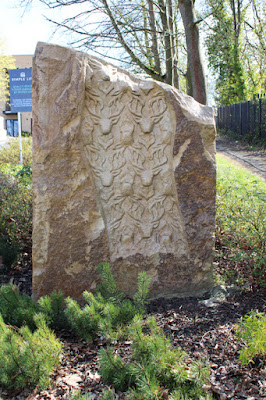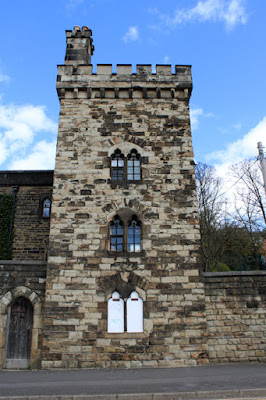 |
| A sculpture at Cutlers Court |
Having achieved my objective of obtaining a sample of crozzle, as well as taking a good look at the building stones in and around Norfolk Heritage Park and briefly exploring Jervis Lum, I set off up Park Grange Road with the intention of photographing Queens Tower and its former lodge for the British Listed Buildings website.
Except to visit Queens Tower very many years ago, I had only passed through this area of Sheffield on the Supertram, but I knew that it was developed with C20 housing and the underlying geology comprised a succession of unnamed sandstones of the Pennine Lower Coal Measures Formation.
Passing a boundary wall that was an extension of the one that I had seen on Norfolk Park Road, I continued up the hill to Queens Towers, only to find that part of the stable block had been redeveloped and a locked gate and a high fence prevented me from getting close to Queens Tower.
Taking a couple of photographs with my camera through the fence, I made my way round to Cutlers Court, where I was delighted to encounter a large block of sandstone that was carved with multiple stag’s heads. I haven’t been able to find any information about it, but I assume that it relates to the ancient Great Sheffield Deer Park.
The stonework of the stable wall, with its castellations and corner turrets, can be seen from the path that runs alongside Cutlers Court and is similar to that seen in many of the buildings that I had already encountered on my walk – light brown in colour, with iron staining giving many blocks an orange colouration.
I couldn’t get near enough to properly assess its physical characteristics, but I could see that the sandstone on the nearest turret had weathered to reveal distinct laminations, with some of the blocks being face bedded and starting to delaminate.
Although I couldn’t get near Queens Tower, which is obscured by its service wing when viewed from the gateway to the site, in one place I did manage to get a glimpse of this wonderful building, which was built in 1839 for Samuel Roberts – a manufacturer of silver plate.
Eventually finding a way around the modern housing estate to the south of Queens Tower, I came to East Bank Road, which runs along an escarpment formed by one of the unnamed sandstones and where the former lodge to Queens Tower is situated.
It is built in a local sandstone of no great quality, with much of the blackened masonry having lost its surface to leave a very patchy appearance; however, I didn’t stop to look closely at the stonework and, after taking a few photographs, I set off to find Heeley Bank Board School.
Eventually finding it, after walking down and then back up the escarpment, I then walked back down to Queens Road, which runs alongside the River Sheaf and is set in an old industrial part of Sheffield, which has seen better days and where historic stone buildings are few and far between.
In one place, however, a row of terraced houses with unusually elaborate dressings caught my eye. I went over to investigate and was very surprised to discover that these were not built in sandstone, as I had assumed, but artificial stone has been used for both the walling and dressings.
Although I found myself in quite an unattractive area and was very tempted to catch a bus from here, the weather was still fine. I therefore decided to carry on along Queens Road and see the Mad Hatter and Queen of Hearts - two sculptures in Birchover gritstone by Vega Bermejo that flank the entrance to Queens Road Retail Park - before walking back to Sheffield city centre.
 |
| The Mad Hatter and the Queen of Hearts |











No comments:
Post a Comment